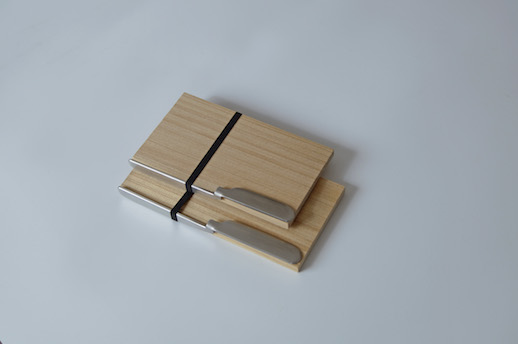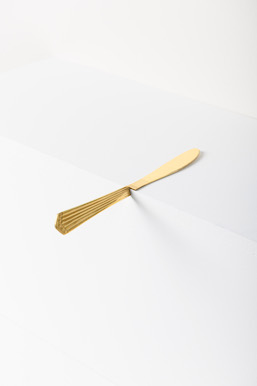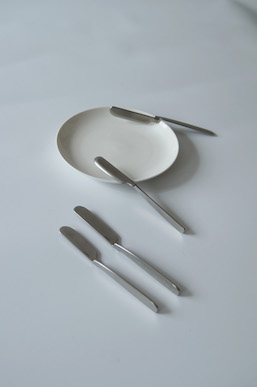Kathleen Reilly: The Road from Glasgow to Tsubame
When first encountering Kathleen Reilly’s work, the viewer glimpses the transubstantiation of everyday objects into other items and experiences altogether. Injected with typical Glaswegian humor, Reilly’s playful and beautiful works, such as a potato chip packet fitted with a zipper, or a series dryly named “Gran’s Plate,” are examples of her deep-seated interest in the quotidian. A graduate of the prestigious Glasgow School of Art and the Royal College of Art, Reilly received the Daiwa Scholarship in 2019 and moved from the UK to the Niigata town of Tsubame, a place renowned for its metalwork. Creating in tandem with the many artisans residing there, the Scottish artist is in the process of taking her current work with cutlery to the next level. In an interview with Tokyo Art Beat, Reilly discusses her background, projects with craftspeople and institutions, her experiences in Tsubame and how text, poetry and Japanese aesthetics have had a profound effect on her artistic output.

Tokyo Art Beat (TAB): You’re an artist and metalworker. How did you get involved in using metal as a creative medium?
Kathleen Reilly (KR): My whole family are artists and musicians so I have been very lucky growing up surrounded by creativity. Nobody in my family, however, has ever specialised in metalwork. I originally wanted to study painting at art school but I took a short jewelry-making class, maybe once a week for a month during high school, and became totally fascinated by the properties of metal. For me, there was something really magical and inspiring in the ability to melt the material down and use it over and over again. There was something I knew I wanted to explore further and know more about…and here we are ten years later.
TAB: Your work involves collaborating with chefs and kitchens. Could you explain more about this and what you hope to achieve through these collaborations?
KR: I have been involved in collaborating with chefs and kitchens for a few years now. I’m currently in the middle of creating a new collection of dishware (for a dinner) with Korean chef Jeong Kwan. This is my second time collaborating with Steinbeisser’s Experimental Gastronomy initiative, which is based in Amsterdam and active around the world. The Experimental Gastronomy events bring together renowned chefs and artists for a one-of-a-kind culinary experience. It is a really exciting project that I am so grateful to be a part of! When collaborating with a chef or kitchen, I find it so important to understand their practice, objectives and goals fully. Usually when I am researching, something about their practice will jump out at me and get me excited. I will then take that as a starting point for my collection of work. For example, right now I am really interested in Jeong Kwan’s philosophy of “food is an expression of what you hold in your mind.” Through these collaborations I hope to achieve not only a body of work that is interesting and engaging for the user, allowing them to think out[side] the conventional table setting, but also by collaborating with a chef, I aim to create fresh narratives, opening new doors for our own future practices, whether it be together or individually. I find that a really beautiful part of collaboration.
TAB: What’s your experience in Tsubame been like? Could you tell me more about your work and life there?
KR: I lived in Glasgow, London and Tokyo before coming to Tsubame, in October 2020, as part of the Daiwa Scholarship program. Being a city girl it has been quite an adjustment living in the countryside, especially as I don’t have a driver’s license! Although the funny thing is, the weather here is almost identical to my hometown of Glasgow (it rains a lot in both cities), so I guess you could say I got used to it quite quickly. For someone who has a degree in metalwork and has studied metal for 10 years now, living in Tsubame, an industrial metalworking town in the heart of Niigata Prefecture, really is a once-in-a-lifetime experience. There are factories and studios on every corner of the city, from hand-engraved file makers, to industrial press machines and of course cutlery factories and showrooms. I have been working and training here for eight months now. My goal is to produce cutlery with the artisans in this area, marrying my design concepts with the high-tech skills of these Japanese craftspeople.
TAB: You were a recipient of the Daiwa Scholarship in 2019. How has this benefitted you and how has this supported your work?
KR: Receiving the Daiwa Scholarship in 2019 was really a life-changing experience. I had always been interested in Japanese design, craftsmanship and the marriage of Scottish and Japanese design aesthetics that I experienced first-hand while studying in the Charles Rennie Mackintosh Building at The Glasgow School of Art. I also studied jewellery design in Japan for a few months back in 2013. However, I had very little knowledge of the Japanese language. I always knew that I wanted to explore Japan more and produce work with Japanese artisans, many of whom don’t speak English, therefore learning Japanese was essential. Oh, I am also very interested in Japanese tanka poetry and wanted to be able to understand the original texts! The Daiwa Scholarship was tough, really a lot tougher than I had ever imagined. I took one year out of my own making practice and focused all of my time on learning Japanese. Which is not an easy language to learn. I am nowhere near fluent but the program has benefited me massively. I can now communicate (enough) to translate my thoughts and ideas to craftsmen in Japanese, and engage in conversations that are benefitting my research and design work, that I would never be able to do in English. Understanding the language has brought me a deeper and richer understanding of Japanese culture that I already know is and will continue to benefit my practice for years to come.
TAB: How has Japan and your experiences here influenced your creative process and work as a whole?
KR: My time in Japan has influenced my creative process and work tremendously. As I already said, learning the Japanese language has brought me a deeper understanding of Japanese culture that is benefitting and influencing my practice in new ways. I am able to have first-hand conversations with craftsmen in factories that often lead to new discoveries or findings. Even casual conversations can lead to something interesting, for example why someone uses a tool in a certain way…I feel when speaking through a translator, often a sense of intimacy can be lost, this intimacy brings closer conversation. My experiences in Japan have also affected my design aesthetic. I definitely have developed more of an appreciation for beauty in simple, authentic and good design with honest materials. I have begun to consider not just the more well-known Japanese aesthetics such as wabi-sabi but also the shibui aesthetic or beauty of the simple, subtle and unobtrusive. There has also been a lot of inspiration found in Japanese table arrangement and place setting that we don’t have in Western culture, for example the dishware used for traditional meals like kaiseki and even chopsticks and chopstick rests.


TAB: Could you explain what you’re currently working on?
KR: I am currently working on a small line of cutlery that I have been developing with Tsubame artisans at a factory here since I moved to Tsubame last October. The release is planned for the end of this year so please do keep an eye out for it!
Utilizing Tsubame City’s generations-old manufacturing techniques and influenced by traditional Japanese place setting and arrangement, the design’s form allows Western cutlery to interact with additional objects at the table in new ways, creating new possibilities for the everyday table setting. (From the press release)
As I touched on earlier, I am also working on a new collection of dishware for Jeong Kwan’s dining event with Steinbeisser that will take place this year.
I have also recently been exploring Toyama Prefecture and Takaoka City’s metal casting techniques for a new project next year.
TAB: On your website you state that:
“By writing poetry she observes and absorbs fleeting moments and unconscious actions within her every day. Key texts are chosen and abstracted to form tangible outcomes. As she associates her writings with the physical world, memories are awoken and juxtapositions formed. Reilly plays with the semiotic qualities of her objects that seemingly flux between circumstance.”
Could you explain more about this?
KR: I have a few facets to my practice. I have my work with chefs and kitchens that are very material and collaboration based. I then have a smaller product line that I am in the middle of developing. Then I have my artworks that this text is in reference to. I use writing to see the “unseen.” I use it as a tool to expand my vision, a way to delve into and consider the subconscious. Instead of starting with a concept and instinctively making and developing work around that concept, I like to write about it. By writing and then rereading these writings, associations and memories are brought to the surface that I would have looked over or perhaps not even thought of. I’m constantly writing small texts or short poems. I hope to publish a book one day in Japanese and English.
Paul McInnes
Paul McInnes



